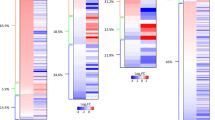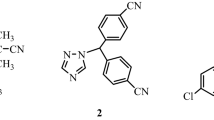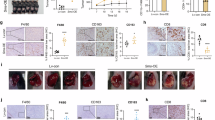Abstract
Human mesenchymal stem cells (hMSCs) can home to tumor sites and inhibit the growth of tumor cells. Little is known about the underlying molecular mechanisms that link hMSCs to the targeted inhibition of tumor cells. In this study, we investigated the effects of hMSCs on two human hepatoma cell lines (H7402 and HepG2) using an animal transplantation model, a co-culture system and conditioned media from hMSCs. Animal transplantation studies showed that the latent time for tumor formation was prolonged and that the tumor size was smaller when SCID mice were injected with H7402 cells and an equal number of Z3 hMSCs. When co-cultured with Z3 cells, H7402 cell proliferation decreased, apoptosis increased, and the expression of Bcl-2, c-Myc, proliferating cell nuclear antigen (PCNA) and survivin was downregulated. After treatment with conditioned media derived from Z3 hMSC cultures, H4702 cells showed decreased colony-forming ability and decreased proliferation. Immunoblot analysis showed that β-catenin, Bcl-2, c-Myc, PCNA and survivin expression was downregulated in H7402 and HepG2 cells. Taken together, our findings demonstrate that hMSCs inhibit the malignant phenotypes of the H7402 and HepG2 human liver cancer cell lines, which include proliferation, colony-forming ability and oncogene expression both in vitro and in vivo. Furthermore, our studies provide evidence that the Wnt signaling pathway may have a role in hMSC-mediated targeting and tumor cell inhibition.
Similar content being viewed by others
Log in or create a free account to read this content
Gain free access to this article, as well as selected content from this journal and more on nature.com
or
References
Pittenger MF, Martin BJ . Mesenchymal stem cells and their potential as cardiac therapeutics. Circ Res 2004; 95:9–20.
Wulf GG, Chapuy B, Trumper L . Mesenchymal stem cells from bone marrow. Phenotype, aspects of biology, and clinical perspectives. Med Klin (Munich) 2006; 101:408–413.
Nakamizo A, Marini F, Amano T, et al. Human bone marrow-derived mesenchymal stem cells in the treatment of gliomas. Cancer Res 2005; 65:3307–3318.
Livraghi T, Meloni F, Frosi A . Treatment with stem cell differentiation stage factors of intermediate-advanced hepatocellular carcinoma: an open randomized clinical trial. Oncol Res 2005; 15:399–408.
Khakoo AY, Pati S, Anderson SA, et al. Human mesenchymal stem cells exert potent antitumorigenic effects in a model of Kaposi's sarcoma. J Exp Med 2006; 203:1235–1247.
Ponte AL, Marais E, Gallay N, et al. The in vitro migration capacity of human bone marrow mesenchymal stem cells: comparison of chemokine and growth factor chemotactic activities. Stem Cells 2007; 25:1737–1745.
Menon LG, Picinich S, Koneru R, et al. Differential gene expression associated with migration of mesenchymal stem cells to conditioned medium from tumor cells or bone marrow cells. Stem Cells 2007; 25:520–528.
Fagioli F, Berger M, Brach del Prever A, et al. Regression of metastatic osteosarcoma following non-myeloablative stem cell transplantation. A case report. Haematologica 2003; 88:ERC16.
Omuro Y, Matsumoto G, Sasaki T, et al. Regression of an unresectable pancreatic tumor following nonmyeloablative allogeneic peripheral-blood stem-cell transplantation. Bone Marrow Transplant 2003; 31:943–945.
Renga M, Pedrazzoli P, Siena S . Present results and perspectives of allogeneic non-myeloablative hematopoietic stem cell transplantation for treatment of human solid tumors. Ann Oncol 2003; 14:1177–1184.
Ringden O, Le Blanc K . Allogeneic hematopoietic stem cell transplantation: state of the art and new perspectives. APMIS 2005; 113:813–830.
Pommey S, Galipeau J . The use of mesenchymal stromal cells in oncology and cell therapy. Bull Cancer 2006; 93:901–907.
Hamada H, Kobune M, Nakamura K, et al. Mesenchymal stem cells (MSC) as therapeutic cytoreagents for gene therapy. Cancer Sci 2005; 96:149–156.
Yuan X, Hu J, Belladonna ML, et al. Interleukin-23-expressing bone marrow-derived neural stem-like cells exhibit antitumor activity against intracranial glioma. Cancer Res 2006; 66:2630–2638.
Studeny M, Marini FC, Dembinski JL, et al. Mesenchymal stem cells: potential precursors for tumor stroma and targeted-delivery vehicles for anticancer agents. J Natl Cancer Inst 2004; 96:1593–1603.
Qiao L, Xu ZL, Tan X, et al. Investigation of inhibition of Wnt/β-catenin pathway in breast cancer cells mediated by Dkk-1 released from human mesenchymal stem cells. Prog Biochem Biophys 2007; 34:702–708.
Lindvall C, Evans NC, Zylstra CR, et al. The WNT signalling receptor, LRP5, is required for mammary ductal stem cell activity and WNT1-induced tumorigenesis. J Biol Chem 2006; 281:35081–35087.
Reya T, Clevers H . Wnt signalling in stem cells and cancer. Nature 2005; 434:843–850.
Reya T, Morrison SJ, Clarke MF, et al. Stem cells, cancer, and cancer stem cells. Nature 2001; 414:105–111.
Willert K, Jones KA . Wnt signalling: is the party in the nucleus? Genes Dev 2006; 20:1394–1404.
Raida M, Heymann AC, Gunther C, et al. Role of bone morphogenetic protein 2 in the crosstalk between endothelial progenitor cells and mesenchymal stem cells. Int J Mol Med 2006; 18:735–739.
Androutsellis-Theotokis A, Leker RR, Soldner F, et al. Notch signalling regulates stem cell numbers in vitro and in vivo. Nature 2006; 442:823–826.
Miele L, Miao H, Nickoloff BJ . NOTCH signalling as a novel cancer therapeutic target. Curr Cancer Drug Targets 2006; 6:313–323.
Gaspar C, Fodde R . APC dosage effects in tumorigenesis and stem cell differentiation. Int J Dev Biol 2004; 48:377–386.
Chen G, Shukeir N, Potti A, et al. Up-regulation of Wnt-1 and beta-catenin production in patients with advanced metastatic prostate carcinoma: potential pathogenetic and prognostic implications. Cancer 2004; 101:1345–1356.
Moon RT, Kohn AD, Ferrari GV De, et al. WNT and beta-catenin signalling: diseases and therapies. Nat Rev Genet 2004; 5:691–701.
Etheridgea SL, Spencera GJ, Heathb DJ, et al. Expression profiling and functional analysis of Wnt signalling mechanisms in mesenchymal stem cells. Stem Cells 2004; 22:849–860.
Gregory CA, Singh H, Perry AS, et al. The Wnt signalling inhibitor Dickkopf-1 is required for reentry into the cell cycle of human adult stem cells from bone marrow. J Biol Chem 2003; 278:28067–28078.
Neth P, Ciccarella M, Egea V, et al. Wnt signalling regulates the invasion capacity of human mesenchymal stem cells. Stem Cells 2006; 24:1892–1903.
Yang F, Zeng Q, Yu G, et al. Wnt/beta-catenin signalling inhibits death receptor-mediated apoptosis and promotes invasive growth of HNSCC. Cell Signal 2006; 18:679–687.
Baek SH, Kioussi C, Briata P, et al. Regulated subset of G1 growth-control genes in response to derepression by the Wnt pathway. Proc Natl Acad Sci USA 2003; 100:3245–3250.
Joubert A, Bianchi P, Maritz C, et al. Influence of prostaglandin A2 on Bax, Bcl-2 and PCNA expression in MCF-7 cells. Biomed Res 2006; 27:157–162.
Muncan V, Sansom OJ, Tertoolen L, et al. Rapid loss of intestinal crypts upon conditional deletion of the Wnt/Tcf-4 target gene c-Myc. Mol Cell Biol 2006; 26:8418–8426.
Zhao Z, Liao L, Cao Y, et al. Establishment and properties of fetal dermis-derived mesenchymal stem cell lines: plasticity in vitro and hematopoietic protection in vivo. Bone Marrow Transplant 2005; 36:355–365.
Liu B, Liu Y, Chen J, et al. CARP is a novel caspase recruitment domain containing pro-apoptotic protein. Biochem Biophys Res Commun 2002; 24:1396–1404.
Prockop DJ, Gregory CA, Spees JL . One strategy for cell and gene therapy: harnessing the power of adult stem cells to repair tissues. Proc Natl Acad Sci USA 2003; 100:11917–11923.
Plas E, Carroll VA, Jilch R, et al. Variations of components of the plasminogen activation system with the cell cycle in benign prostate tissue and prostate cancer. Cytometry 2001; 46:184–189.
Lengronne A, Pasero P, Bensimon A, Schwob E . Monitoring S phase progression globally and locally using BrdU incorporation in TK+ yeast strains. Nucleic Acids Res 2001; 29:1433–1442.
Kaiser MJ, Tiegs G, Neuhuber WL . Close apposition of dynorphin-positive nerve fibres to lymphocytes in the liver suggests opioidergic neuroimmunomodulation. Histochem Cell Biol 2003; 120:213–221.
Acknowledgements
This work was supported by grants from the National Basic Research Program of China (973 Program, No. 2007CB914800 to Xiaodong Zhang), National Natural Science Foundation of China (No. 30570698 to Xiaodong Zhang) and Tianjin Natural Scientific Foundation (No. 033801211 to Xiaodong Zhang).
Author information
Authors and Affiliations
Corresponding authors
Rights and permissions
About this article
Cite this article
Qiao, L., Xu, Z., Zhao, T. et al. Suppression of tumorigenesis by human mesenchymal stem cells in a hepatoma model. Cell Res 18, 500–507 (2008). https://doi.org/10.1038/cr.2008.40
Received:
Revised:
Accepted:
Published:
Issue date:
DOI: https://doi.org/10.1038/cr.2008.40
Keywords
This article is cited by
-
Menstrual blood-derived endometrial stem cell, a unique and promising alternative in the stem cell-based therapy for chemotherapy-induced premature ovarian insufficiency
Stem Cell Research & Therapy (2023)
-
Shining the light on mesenchymal stem cell-derived exosomes in breast cancer
Stem Cell Research & Therapy (2023)
-
Mesenchymal stem cell-released oncolytic virus: an innovative strategy for cancer treatment
Cell Communication and Signaling (2023)
-
Multiple Dimensions of using Mesenchymal Stem Cells for Treating Liver Diseases: From Bench to Beside
Stem Cell Reviews and Reports (2023)
-
Evaluation of Human Wharton’s Jelly-Derived Mesenchymal Stem Cells Conditioning Medium (hWJ-MSCs-CM) or Scorpion Venom Breast Cancer Cell Line In Vitro
Journal of Gastrointestinal Cancer (2022)



